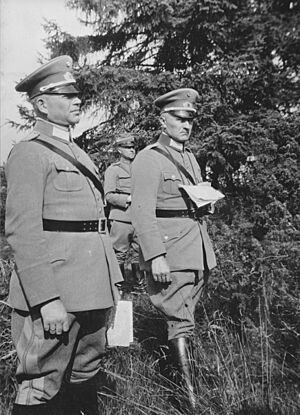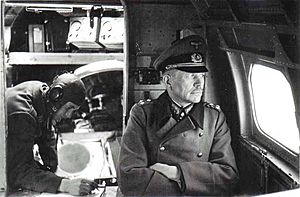Heinz Guderian facts for kids
Quick facts for kids
Heinz Guderian
|
|
|---|---|
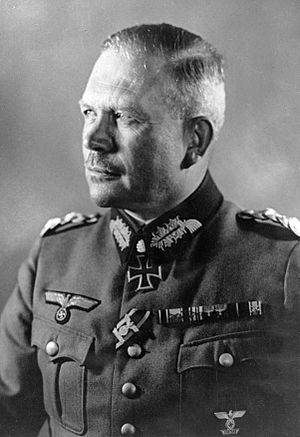
Guderian in July 1941
|
|
| Chief of the General Staff of the German Army High Command |
|
| In office 21 July 1944 – 28 March 1945 |
|
| Leader | Adolf Hitler |
| Preceded by | Adolf Heusinger |
| Succeeded by | Hans Krebs |
| Personal details | |
| Born |
Heinz Wilhelm Guderian
17 June 1888 Kulm, Prussia, German Empire (now Chełmno, Poland) |
| Died | 14 May 1954 (aged 65) Schwangau, Bavaria, West Germany |
| Spouse |
Margarete Goerne
(m. 1913) |
| Children | Heinz-Günther Guderian |
| Awards | Knight's Cross of the Iron Cross with Oak Leaves |
| Signature | |
| Nicknames | Schneller Heinz Hammering Heinz |
| Military service | |
| Allegiance | German Empire (1907–1918) Weimar Republic (1919–1933) Nazi Germany (1933–1945) |
| Branch | Imperial German Army Reichsheer German Army |
| Years of service | 1907–1945 |
| Rank | Generaloberst |
| Commands | 2nd Panzer Division XVI Army Corps XIX Army Corps 2nd Panzer Army |
| Battles/wars |
|
Heinz Wilhelm Guderian (German: [ɡuˈdeːʁi̯an]; 17 June 1888 – 14 May 1954) was a German general during World War II. He was a key person in developing the "blitzkrieg" (lightning war) approach. He also helped create the idea of the panzer division (tank division). After the war, he wrote a popular book about his experiences.
At the start of World War II, Guderian led a tank corps in the Invasion of Poland. During the invasion of France, he commanded the tank units that attacked through the Ardennes forest. They surprised the Allied defenses at the Battle of Sedan. He then led the 2nd Panzer Army during Operation Barbarossa, the invasion of the Soviet Union. This campaign failed to capture Moscow, and Guderian was removed from his command.
In 1943, Adolf Hitler made Guderian the Inspector General of Armored Troops. This job gave him a lot of power to rebuild and train new tank forces. However, Germany's war situation made this difficult. Guderian later became the Acting Chief of the Army High Command after a plot to assassinate Hitler. He was a personal advisor to Hitler on the Eastern Front. Guderian surrendered to American forces in May 1945. He was held until 1948 and then released without charges. He wrote his memoirs, Panzer Leader, which became a bestseller.
Contents
Early Life and World War I
Heinz Guderian was born in Kulm, which was then part of Prussia (now Poland), on 17 June 1888. His father and grandfathers were officers in the Prussian army. He grew up in military towns. In 1903, he joined a military cadet school. He became an officer cadet in 1907 and a second lieutenant in 1908. In 1913, he married Margarete Goerne. They had two sons, Heinz Günther and Kurt.
When World War I began, Guderian worked as a communications officer. He was promoted to first lieutenant in 1914. He was in charge of signals intelligence for the German 4th Army. He fought in the Battle of Verdun and became a captain in 1915. He finished the war as an operations officer in occupied Italy. He did not agree with Germany signing the armistice in 1918. He believed Germany should have kept fighting.
Between the World Wars
In 1919, Guderian was one of only 4,000 officers allowed to stay in the German army. This was because the Treaty of Versailles limited the size of Germany's military. He worked to defend Germany's eastern borders.
In the 1920s, Guderian learned about armored warfare from Ernst Volckheim, a tank commander. Guderian studied books about tank warfare from other European countries. He also wrote articles for a military journal. He became an instructor in 1924. In 1927, he was promoted to major. He became a leading speaker on tanks, even though he didn't drive one until 1929. In 1931, he was promoted to lieutenant-colonel. He became chief of staff for the Inspectorate of Motorized Troops. This put him at the center of Germany's efforts to develop mobile warfare and tank forces.
Developing Tank Divisions and Blitzkrieg
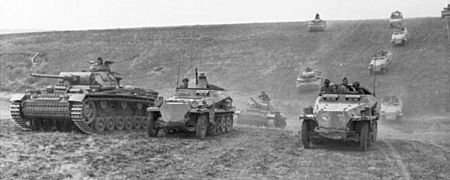
In the 1930s, Guderian played a big part in creating the idea of the panzer division (tank division). He also helped develop the strategy of fast, offensive tank warfare, later called blitzkrieg. His ideas for a motorized battalion became a model for Germany's future tank forces.
Guderian worked closely with his boss, Oswald Lutz. Both wanted to create a strong tank force. Guderian was the public face, promoting tank warfare. Lutz worked behind the scenes. Guderian even showed his ideas to Hitler. Many other officers also helped develop these ideas. However, Guderian is known for pioneering the communication system used in tank units. The main ideas of blitzkrieg – moving quickly, attacking in large groups, and surprising the enemy – were first written down by Lutz.
In 1936, Guderian wrote a book called Achtung – Panzer! The book promoted the idea of strategic mechanized warfare. It discussed how to supply tanks with fuel and parts, and how to move large tank forces.
In 1938, Hitler removed army officers who didn't support the Nazi regime. Guderian replaced Lutz. That spring, Guderian commanded a tank force during the annexation of Austria. The operation was messy, with tanks running out of fuel or breaking down. Guderian worked to fix these problems. In the year before World War II, Guderian became closer to Hitler. He was invited to dinner and attended opera with him. When Hitler took over the Sudetenland, Guderian's tank corps was part of the occupation.
Second World War
Invasion of Poland
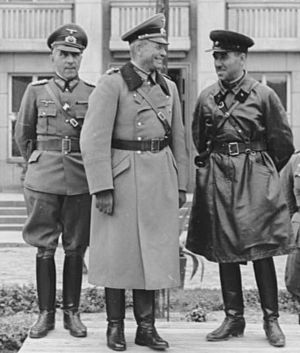
In August 1939, Guderian took command of the new XIX Army Corps. He was ordered to lead the northern part of the invasion of Poland, which started on 1 September. His corps had one of Germany's six tank divisions. His job was to advance through West Prussia, then East Prussia, and finally south towards Warsaw. Guderian often went to the front lines to see the situation himself. He used a radio-equipped command vehicle to stay in touch with his corps.
By 5 September, Guderian's corps had met up with forces from East Prussia. He had won his first major battle. He showed the battlefield to Hitler. The next day, he moved his corps to advance on Warsaw. By 9 September, his corps was strengthened, and he continued deeper into Poland, reaching Brest-Litovsk. In ten days, Guderian's corps advanced 330 kilometers (205 miles). The tank proved to be a powerful weapon. Only 8 out of 350 tanks were destroyed. On 16 September, Guderian attacked Brest Litovsk. The next day, the Soviet Union invaded Poland. Guderian gave the city an ultimatum: surrender to the Germans or Soviets. The city surrendered to the Germans. After the campaign, Guderian received the Knight's Cross of the Iron Cross.
Invasion of France and the Low Countries
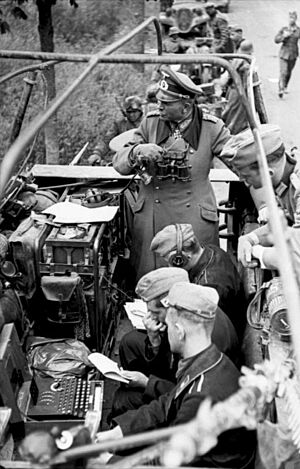
Guderian was part of the discussions before the invasion of France and the Low Countries. The plan, called the Manstein Plan, moved the main tank attack through the Ardennes Forest. Guderian was confident that tanks could get through the hilly Ardennes. He was given seven mechanized divisions for this task. This was the largest group of German tanks ever assembled for an attack.
Guderian's corps led the attack through the Ardennes and across the Meuse River. He led the attack that broke the French lines at the Battle of Sedan. Guderian's tank group then led the "race to the sea." This trapped the British and French forces at Dunkirk. A British counter-attack at Arras on 21 May slowed the German advance. Hitler then ordered a halt to the attack. The attack resumed on 26 May, but Allied forces fought back strongly. On 28 May, Guderian suggested stopping the tank assault. He was then ordered to advance to the Swiss border. The offensive started on 9 June and ended on 17 June. It surrounded the Maginot Line defenses and the remaining French forces.
The French defeat was not certain. The French had good military equipment and were not outnumbered. Their loss came from low morale, poor strategy, and a lack of coordination among Allied troops. After this victory, Hitler and his generals became very confident. They believed they could defeat the Soviet Union, a country with many more resources and people.
Invasion of the Soviet Union

In his 1937 book, Guderian had warned that Germany would face a serious challenge from Russia's technology. However, during the planning for Operation Barbarossa (the invasion of the Soviet Union), he became very optimistic. He believed German weapons were superior. By May 1941, Guderian accepted Hitler's view that the invasion was a necessary strike.
Guderian's 2nd Panzer Group began its attack on 22 June. They crossed the Bug River and moved towards the Dnieper River. The 2nd and 3rd Panzer Groups surrounded the Minsk pocket, taking 300,000 prisoners. Then they attacked towards Smolensk. Guderian received the Knight's Cross with Oak Leaves on 17 July 1941. After the Battle of Smolensk, General Franz Halder wanted to drive straight to Moscow. Halder had Guderian fly to Hitler's headquarters to argue for this plan. Guderian, who had recently opposed Hitler's plan to attack south, surprisingly sided with Hitler. This angered Halder and Field Marshal Fedor von Bock.
By 15 September, German forces, including Guderian's 2nd Panzer Group, had completed the largest encirclement in history: the Battle of Kiev. The German army destroyed the Soviet Southwestern Front east of Kiev, causing over 600,000 losses. However, the campaign was costly. German forces had only half the tanks they had three months earlier. They were stuck in a long, difficult war. Guderian's 2nd Panzer Group was in the worst shape, with only 21 percent of its tanks working. In mid-September, he was ordered to drive towards Moscow. The Battle of Moscow began on 30 September. On 4 October, Guderian's 4th Panzer Division faced a major setback near Oryol. Guderian asked for an investigation into tank warfare on the Eastern Front. In November, he suggested copying the Soviet T-34 tank.
By November, the attack by the 2nd Panzer Group on Tula and Kashira, 125 kilometers (78 miles) south of Moscow, had limited success. Guderian was dismissed from command on 25 December.
Inspector General of Armored Troops
On 1 March 1943, after the German defeat at Battle of Stalingrad, Hitler appointed Guderian as the Inspector General of Armored Troops. Guderian had pushed to be given a new role. His job was to oversee the tank arm and train Germany's tank forces. He worked with Albert Speer on making and developing armored vehicles. However, Germany's military problems in 1943 prevented Guderian from fully restoring the power of the armored forces. He had some success improving tank destroyers and fixing problems with new tanks like the Panther and Tiger.
Operation Citadel, Germany's last major offensive in the east, was an attempt to regain control. Guderian was against this attack. He told Hitler, "Why are we attacking in the east at all this year?" Hitler replied, "You are right. Whenever I think of this attack, my stomach turns over." Guderian concluded, "Then you have the right attitude towards this situation. Leave it alone."
Acting Chief of Army General Staff
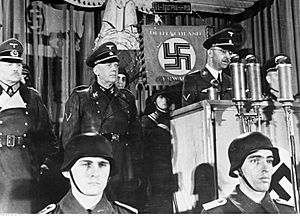
Guderian became the Acting Chief of the General Staff of the Army High Command. His job was to advise Hitler on the Eastern Front. He took over after General Kurt Zeitzler left the position.
Germany was already facing defeat. Guderian could not change the military situation or Hitler's decisions. Hitler put Guderian in charge of the "Honour Court." This court was used to remove people from the military who were accused of being involved in the 20 July Plot to assassinate Hitler. After being removed from the military, these people could be tried by another court and executed. Guderian later said he found these sessions "repulsive."
As head of the Army High Command, Guderian faced problems with staff being arrested. He had to fill many important positions. Many new staff members lacked experience. Guderian also had a long-standing dislike for the General Staff. He blamed them for opposing his ideas about modern tank warfare in the 1930s. The end of 1944 saw increasing conflict between the Army High Command and the Oberkommando der Wehrmacht (Armed Forces High Command). They competed for resources, especially before the Battle of the Bulge, Germany's last major offensive in the west. After the war, Guderian blamed Hitler for wasting Germany's last reserves in this operation. However, Germany's situation was so bad that even more divisions would not have helped.
Guderian made it mandatory for all officers to join the Nazi party. He also made the Nazi salute required throughout the armed forces. He supported the military becoming more political. At a rally in November 1944, Guderian said that "95 million National Socialists stand behind Adolf Hitler." On 28 March 1945, Guderian was sent on leave after a failed operation. General Hans Krebs replaced him.
Guderian had close relationships with powerful people in the Nazi regime. He had dinner with Heinrich Himmler on Christmas Day 1944. On 6 March 1945, Guderian took part in a propaganda broadcast. Despite his later claims of being against the Nazis, Hitler likely saw Guderian's beliefs as similar to Nazi ideas. Hitler brought him out of retirement in 1943 and valued his actions after the failed assassination plot.
Later Life and Death
Guderian and his staff surrendered to American forces on 10 May 1945. He was not charged as a war criminal at the Nuremberg Trials. He answered questions from the Allied forces and denied being a strong supporter of Nazism. He worked with the US Army Historical Division. The US refused requests from the Soviet Union to hand him over. Even after the war, Guderian still had some positive feelings towards Hitler and National Socialism. While held by the Americans, his conversations were secretly recorded. In one recording, Guderian said, "The fundamental principles [of Nazism] were fine."
Guderian was released in 1948. Many other generals were not as lucky. Guderian had cooperated with the Allies, which helped him avoid prosecution. He retired to Schwangau in Bavaria and began writing. His most successful book was Panzer Leader. He remained a strong German nationalist for the rest of his life. Guderian died on 14 May 1954 at age 65. He is buried in Goslar.
Writings and Legacy
The Panzer Leader Story
Guderian's book Panzer Leader was very popular. In it, he presented himself as the main inventor and "father" of the German tank arm. He claimed to be the master of blitzkrieg between 1939 and 1941. However, this was an exaggeration. Guderian's German book was first published in 1950. At that time, it was one of the few sources about the development of tank forces. Because of this, historians often relied on Guderian's book. Later biographers also supported this idea. In 1952, Guderian's book was printed in English. A British military writer, B. H. Liddell Hart, asked Guderian to say that his military ideas were based on Liddell Hart's work. Guderian agreed. In return, Liddell Hart supported Germany rebuilding its army.
In more recent studies, historians have started to question Guderian's book. They criticize the story it created. Historian Pier Battistelli says Guderian was not the only "father" of the tank arm. He was one of many innovators. He stood out because he sought attention and had a close relationship with Hitler. By presenting himself as the father of blitzkrieg and working with the Americans, he avoided being sent to the Soviet Union. Battistelli believes Guderian's greatest skill was as an author. His books Achtung-Panzer! and Panzer Leader were successful and are still discussed today.
Guderian was a skilled tactician and technician. He led his troops well in the Invasion of Poland, the Battle of France, and the early parts of the invasion of the Soviet Union. This included the advance to Smolensk and the Battle of Kiev. However, he often succeeded from strong positions. His strengths were sometimes outweighed by his weaknesses. For example, he created bad feelings between his tank forces and other parts of the military. His memoirs also left out his military failures and his close ties to Hitler. James Corum writes that Guderian was an excellent general and tactician. He played a central role in developing tank divisions, regardless of what his memoirs claimed.
The "Clean Wehrmacht" Idea
Battistelli writes that Guderian changed history in his memoirs. He notes that the biggest change was covering up his involvement in actions during Operation Barbarossa. Units under his command carried out orders that led to the killing of Soviet political officers. He was also involved in actions after the Warsaw Uprising of 1944.
Like other generals, Guderian's memoirs stressed his loyalty to Germany. However, he did not mention that Hitler gave him gifts, including land and monthly payments. Guderian wrote in his memoirs that he was given a Polish estate as a retirement gift. This estate was worth 1.24 million Reichsmarks and covered 2,000 acres (810 hectares). The people living there had been forced out. Guderian also did not mention that he had first asked for an estate three times larger, but was denied.
In 1950, Guderian published a pamphlet. In it, he said that the Western powers had allied with the wrong side during the war. Guderian defended Hitler and claimed that only the Nazi civilian government was responsible for actions against Soviet civilians. He blamed Hitler and the Russian winter for Germany's military defeats. He also wrote that six million Germans died during their removal from Eastern territories. He claimed that those executed at the Nuremberg trials were "defenders of Europe."
Authors Ronald Smelser and Edward J. Davies say that Guderian's memoirs are full of "untruths, half truths, and omissions." Guderian claimed that certain orders were not carried out by his troops. He also claimed to have been kind to civilians and to have protected Russian cultural objects. He said his troops had "liberated" Soviet citizens.
Historian David Stahel writes that English-speaking historians too easily presented a false image of German generals after the war. He states that the generals "willingly partook in the genocide of the Nazi regime."
Works
- Achtung – Panzer! (1937)
- Panzer Leader (1950)
Awards
- Iron Cross (1914)
- 2nd Class (17 September 1914)
- 1st Class (8 November 1916)
- Knight 2nd class of the Friedrich Order with Swords (Württemberg) (15 December 1915)
- Saxe-Ernestine House Order Commander 2nd Class with Swords (1 July 1935)
- Wehrmacht Long Service Award 1st Class (1 October 1936)
- Royal Hungarian War Memorial Medal with Swords (14 January 1937)
- Honour Cross of the World War 1914/1918
- War Memorial Medal with Swords (Austria) (9 March 1937)
- Anschluss Medal (13 March 1938)
- Order of St. Sava 1st Class (21 November 1939)
- Clasp to the Iron Cross (1939)
- 2nd Class (5 September 1939)
- 1st Class (13 September 1939)
- Knight's Cross of the Iron Cross with Oak Leaves
- Knight's Cross on 27 October 1939 as General der Panzertruppe and commanding general of the XIX. Army Corps
- 24th Oak Leaves on 17 July 1941 as Generaloberst and commander-in-chief of the 2nd Panzer Group
See also
 In Spanish: Heinz Guderian para niños
In Spanish: Heinz Guderian para niños
- Guderian-Plan – a plan for fortifying the German East Front in 1944


